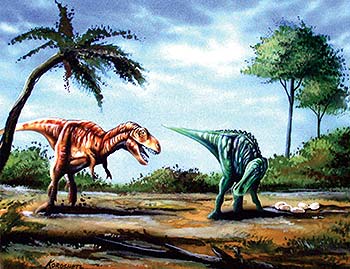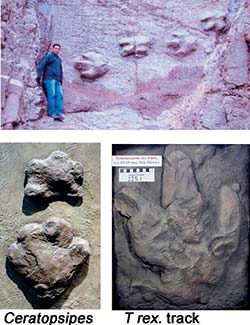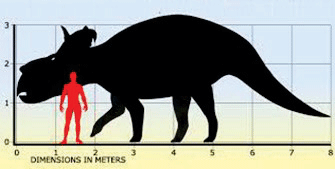 |
| Hadrosaur from the Cretaceous of Peru (top); Ceratopsipes 5-toed, front and 4-toed hind tracks. Three toed T. rex track with robust, wide traces of toes II-IV. The small hallux (digit I trace, bottom left) fits T. rex foot skeleton. This scene, where T. rex menaces a duck billed hadrosaur, is typical of the popular image of life in the Late Cretaceous. Artwork by Paul Koroshetz. |
Geologists often liken the layers of strata in the Earth’s crust to the pages of a book. A prime example of this metaphor (in some cases used as a simile) comes from the local Book Cliffs which form a spectacular geological feature extending for about 150 miles across the southern portion of the Dinosaur Diamond from the Grand Valley in Colorado to Price in Utah. The Book Cliffs are famous for having produced coal and dinosaur tracks, known to geologists from at least as early as the 1920s, and excavated from coal mines for more than a century. The age of these rocks, traditionally named the Mesa Verde Group, is Late Cretaceous (100-65 million years). Just as “groups” are made up of smaller units (formations) so time units such as the late Cretaceous are divided into stages. The Book Cliffs expose layers that have been dated as Campanian (84- 72 million years). The difference between a book and a strata image is that when one digs down through strata one is excavating into older, deeper layers, whereas when one reads a book the story gets younger as one progresses. Precisely because we like our stories to have a timelines geologists read the layers from the bottom up.
The traditional image of Late Cretaceous dinosaurs in North America includes depictions of large duck billed dinosaurs or hadrosaurs and large ceratopsian horned dinosaurs like Triceratops, usually depicted as under dramatic attack by Tyrannosaurus rex. The track record supports such reconstructions by revealing the trend of increase in maximum size of the footprints of all these groups. Upper Cretaceous hadrosaur tracks named Hadrosauropodus are often 3 feet wide and long, twice the size of lower Cretaceous ornithopod tracks. However, while these large dinosaur tracks are historically important, the Mesa Verde has also yielded the tracks of much smaller animals including turtles, frogs and birds: see future issues of Happenings).
 |
| Top: a hadrosaur trackway from the Upper Cretaceous of Peru; Ceratopsipes a 5-toed, front and 4-toed hind tracks from Golden Colorado. A three-toed T. rex track with robust, wide traces of toes II-IV from northern New Mexico. The small hallux (digit I trace, bottom left) fits a T. rex foot skeleton. All are larger than tracks of their Lower Cretaceous ancestors. The hadrosaur tracks could be mistaken for ceratopsian hind footprints (as happened in early reports). The difference is seen in the lack of front footprints and the pronounced inward rotation of the tracks in the trackways of horned dinosaurs. |
We can gain some insight into the excitement generated back east by the discovery of large dinosaur tracks in the Dinosaur Diamond area by looking at the early reports, one of which dealt with a large three-toed tracks from near Thompson, Utah. This is not to mention the large-scale excavation of hadrosaur tracks from near Cedaredge, Colorado. The geologist who reported the track from 8 miles north of Thompson Springs, Utah, consulted American Museum paleontologist William Diller Mathew who interpreted the track as belonging to the family of dinosaurs, of which Tyrannosaurus is the largest known type “representing “the climax of evolution of the flesh eating dinosaurs:” i.e., the theropods. How many travelers whizzing by Thompson Springs on the interstate might suspect that a track found nearby would stimulate debate about theropod evolution? It is a yet-to-be-solved mystery as to why the climax of evolution of many dinosaur groups is manifest in such large size? Perhaps it was to deter smaller predators.? However, the pattern is sufficiently common in dinosaurs, and mammal groups such as the horse family, as to have been labeled as Cope’s Rule in honor of the famous paleontologist Edward Drinker Cope.
This evolutionary pattern, affecting size, is clearly seen in the horned dinosaurs or ceratopsians as well as among ornithopods and theropods. Early, primitive dinosaurs were the size of turkeys and bipedal, whereas in the very latest Cretaceous Triceratops were as the size of large elephant. Although skeletons are common Triceratops tracks, named Ceratopsipes are rare, and known mainly from the Golden area near Denver and the Debeque area of the eastern Grand Valley. Likewise, the size of tracks from the tyrannosaurid family increased through time. Even though explanations for these size trends are not fully understood the fact that they occur repeated strongly supports certain regular organizational patterns in evolution. Track data points also outnumber skeletal fossils.
 |
| Triceratops was one of many elephant-sized horned dinosaurs which were much smaller than their ancestors. They support the concept of Cope’s Rule which recognizes an increase in maximum size of dinosaur and other groups with time. |
|